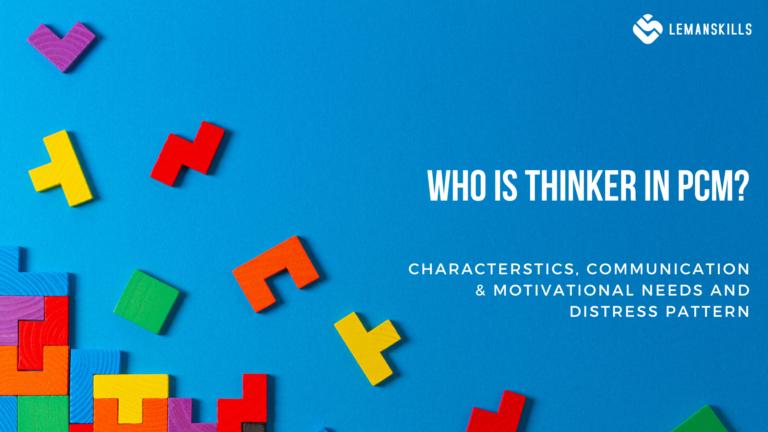
Process Communication Model (PCM): Promoter
Can you recall any situation when a person went straight into doing things, sometimes without more in-depth analysis? Maybe too risky in your head? Or maybe it’s a person who is always in the movement, never sits in one place, and you feel like they live 3 lives in 1? That’s The Promoter. The third of six personality types in Process Communication Model. We’ve already covered two of them: Persister and Thinker. Today we go into the next one, filling out the gaps in knowledge so it all makes sense after we cover everything. We’ll have the base on we can stand to start acting on it: not only KNOW from the rational perspective what we should do. Doing and practice: that’s what is the most important for the Promoter in the PCM personality Base. Let’s go into this world today to check what is the whole fuss about. How do we recognize Promoter? Promoter is a person who experience the world through the lens of doing things, acting on them, movement. Their perception is action itself, since they use their delivery part of themselves the most frequently. They always look for excitement and change in what is happening in their life, when they get a task, project or want to decide on something. The things around them need to be different, challenging, new. They don’t want to wait: they want to experience the world here and now. How to recognize a Promoter in the Base of personality? Again, the easiest way to make a strong hypothesis is to look for the key words that the person uses the most. For Promoter it will be: “Let’s go!”, “Let’s do things!?”, “Why to wait: let’s go and do it now!”, “doing…”, “walking the walk…”, “no more talking, let’s do things”. They say all of that because for them what’s important is seeing the results of their actions. They hate to wait, overanalyze, focusing on too many details. What’s important for them is to go, do things, see what happens and calibrate if needed. The recognition of Promoter is also easier when we look on their non-verbal communication: most of the time they have the furrows between the eyebrows (lion’s wrinkle), their voice is rather strong, they talk fast since they don’t want to waste time. Moderate gestures and body language, rather adjusted to the aim they have to achieve. If you see and hear it, that’s a strong indicator that there’s a Promoter in the Base on the other side of the communication process. How to use it to get along with that kind of person? What does Promoter need in communication? The Promoter needs communication process where they have a chance to go straight to the action. Extremely important for them as well is to know what to do, have space to do it and act as soon as possible. To be efficient in communication with Promoter, we need to use directive channel of communication (quite different than we had in Persister’s and Thinker’s story). Directive channel means that we create a sentence with a dot at the end of it. Promoter doesn’t want to waste time, so asking them questions or small talk is a nonsense, will never work. That means that we need to directly tell them whats’ there to be done. Using the same example that we got in the Persister’s and Thinker’s case: when we want to delegate a task, so a chosen employee covers it, the great approach will be just telling them about it. “Please go and do a task X, the deadline for it is Y”. Honestly: it’s all they need, nothing fancy. They value Autocratic interaction style. It means that they are the most efficient when the other person just tells them what is there to be done and leave them alone, so they can go and focus on the delivery. Straight to the point, sometimes (especially for the people that are not so big fans of a directive communication channel” might look a little harsh or cold. But for them, it’s perfect. Promoter seek to answer the existential question: am I alive? It’s good to feed that question, especially when we see that Promoter is under some kind of stress or pressure. For them the following equation is the only truth. I’m alive = I can deliver value to the world Motivational needs attached to this PCM type is It’s important to know it, since when those needs are not met, Promoter goes into distress and loses access to their skills, abilities to think clearly. Excitement means that Promoter needs to have stimuli, things to do, new projects, environment, tasks to cover. This need can be covered equally good in private as in professional life. But the important thing is that boredom, monotonous tasks or circumstances is the worst thing that can happen to Promoter. When do we know that Promoter is in distress? Just a reminder: distress is negative stress, that costs us (and our environment) something. We are in distress when our motivational needs are frustrated and to cover them (in a really bizarre way), we into the distress sequence. How does is look like for a Promoter? Driver: you need to be strong for me (meaning: you are OK only if you are strong). On this level, Promoter will expect that people will suck it up, that they do everything on their own, without asking for help (which is weakness). When we see that kind of behavior, we can offer more excitement, changing the environment (going for the walk is sometimes enough), give a new task (even if it’s super small and might look stupid). Blamer Mask. Promoter wears a blamer mask on the second level of distress. It their case it means that they start to manipulate others, set up arguments, sometimes create negative drama. Everything to cover their need of excitement since they are bored. And drama is better than boredom. Cellar: At the






